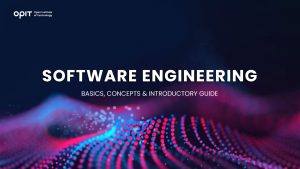

In April 1999, a $433 million Air Force rocket inexplicably malfunctioned almost immediately after liftoff, causing the permanent loss of an $800 million military communications satellite. This $1.2 billion disaster remains one of the costliest accidents in human history.
You might wonder if scientists ever found out what caused this misfiring. They sure did! And the answer is a software bug.
This accident alone is a testament to the importance of software testing.
Although you can probably deduce the software testing definition, let’s also review it together.
So, what is software testing?
Software testing refers to running a software program before putting it on the market to determine whether it behaves as expected and displays no defects.
While testing itself isn’t free, these expenses are cost-effective compared to potential money loss resulting from software failure. And this is just one of the benefits of this process. Others include improving performance, preventing human and equipment loss, and increasing stakeholder confidence.
Now that you understand why software testing is such a big deal, let’s inspect this process in more detail.
Software Testing Fundamentals
We’ll start with the basics – what are the fundamentals of testing in software engineering? In other words, what exactly is its end goal, and which principles underlie it?
Regarding the objectives of software testing, there are three distinct ones aiming to answer crucial questions about the software.
- Verification and validation. Does the software meet all the necessary requirements? And does it satisfy the end customer?
- Defects and errors identification. Does the software have any defects or errors? What is their scope and impact? And did they cause related issues?
- Software quality assurance. Is the software performing at optimal levels? Can the software engineering process be further optimized?
As for principles of software testing, there are seven of them, and they go as follows:
- Testing shows the presence of defects. With everything we’ve written about software testing, this sounds like a given. But this principle emphasizes that testing can only confirm the presence of defects. It can’t confirm their absence. So, even if no flaws are found, it doesn’t mean the system has none.
- Exhaustive testing is impossible. Given how vital software testing is, this process should ideally test all the possible scenarios to confirm the program is defect-free without a shadow of a doubt. Unfortunately, this is impossible to achieve in practice. There’s simply not enough time, money, or space to conduct such testing. Instead, test analysts can only base the testing amount on risk assessment. In other words, they’ll primarily test elements that are most likely to fail.
- Testing should start as early as possible. Catching defects in the early stages of software development makes all the difference for the final product. It also saves lots of money in the process. For this reason, software testing should start from the moment its requirements are defined.
- Most defects are within a small number of modules. This principle, known as defect clustering, follows the Pareto principle or the 80/20 rule. The rule states that approximately 80% of issues can be found in 20% of modules.
- Repetitive software testing is useless. Known as the Pesticide Paradox, this principle warns that conducting the same tests to discover new defects is a losing endeavor. Like insects become resistant to a repeatedly used pesticide mix, the tested software will become “immune” to the same tests.
- Testing is context-dependent. The same set of tests can rarely be used on two separate software programs. You’ll need to switch testing techniques, methodologies, and approaches based on the program’s application.
- The software program isn’t necessarily usable, even without defects. This principle is known as the absence of errors fallacy. Just because a system is error-free doesn’t mean it meets the customer’s business needs. In software testing objectives, software validation is as important as verification.
Types of Software Testing
There are dozens (if not hundreds) types of testing in software engineering. Of course, not all of these tests apply to all systems. Choosing the suitable types of testing in software testing boils down to your project’s nature and scope.
All of these testing types can be broadly classified into three categories.
Functional Testing
Functional software testing types examine the system to ensure it performs in accordance with the pre-determined functional requirements. We’ll explain each of these types using e-commerce as an example.
- Unit Testing – Checking whether each software unit (the smallest system component that can be tested) performs as expected. (Does the “Add to Cart” button work?)
- Integration Testing – Ensuring that all software components interact correctly within the system. (Is the product catalog seamlessly integrated with the shopping cart?)
- System Testing – Verifying that a system produces the desired output. (Can you complete a purchase?)
- Acceptance Testing – Ensuring that the entire system meets the end users’ needs. (Is all the information accurate and easy to access?)
Non-Functional Testing
Non-functional types of testing in software engineering deal with the general characteristics of a system beyond its functionality. Let’s go through the most common non-functional tests, continuing the e-commerce analogy.
- Performance Testing – Evaluating how a system performs under a specific workload. (Can the e-commerce shop handle a massive spike in traffic without crashing?)
- Usability Testing – Checking the customer’s ability to use the system effectively. (How quickly can you check out?)
- Security Testing – Identifying the system’s security vulnerabilities. (Will sensitive credit card information be stored securely?)
- Compatibility Testing – Verifying if the system can run on different platforms and devices. (Can you complete a purchase using your mobile phone?)
- Localization Testing – Checking the system’s behavior in different locations and regions. (Will time-sensitive discounts take time zones into account?)
Maintenance Testing
Maintenance testing takes place after the system has been produced. It checks whether (or how) the changes made to fix issues or add new features have affected the system.
- Regression Testing – Checking whether the changes have affected the system’s functionality. (Does the e-commerce shop work seamlessly after integrating a new payment gateway?)
- Smoke Testing – Verifying the system’s basic functionality before conducting more extensive (and expensive!) tests. (Can the new product be added to the cart?)
- Sanity Testing – Determining whether the new functionality operates as expected. (Does the new search filter select products adequately?)
Levels of Software Testing
Software testing isn’t done all at once. There are levels to it. Four, to be exact. Each level contains different types of tests, grouped by their position in the software development process.
Read about the four levels of testing in software testing here.
Level 1: Unit Testing
Unit testing helps developers determine whether individual system components (or units) work properly. Since it takes place at the lowest level, this testing sets the tone for the rest of the software development process.
This testing plays a crucial role in test-driven development (TDD). In this methodology, developers perform test cases first and worry about writing the code for software development later.
Level 2: Integration Testing
Integration testing focuses on the software’s inner workings, checking how different units and components interact. After all, you can’t test the system as a whole if it isn’t coherent from the start.
During this phase, testers use two approaches to integration testing: top-down (starting with the highest-level units) and bottom-up (integrating the lowest-level units first).
Level 3: System Testing
After integration testing, the system can now be evaluated as a whole. And that’s exactly what system testing does.
System testing methods are usually classified as white-box or black-box testing. The primary difference is whether the testers are familiar with the system’s internal code structure. In white-box testing, they are.
Level 4: Acceptance Testing
Acceptance testing determines whether the system delivers on its promises. Two groups are usually tasked with acceptance testing: quality assessment experts (alpha testing before the software launches) and a limited number of users (beta testing in a real-time environment).
Software Testing Process
Although some variations might exist, the software testing process typically follows the same pattern.
Step 1: Planning the Test
This step entails developing the following:
- Test strategy for outlining testing approaches
- Test plan for detailing testing objectives, priorities, and processes
- Test estimation for calculating the time and resources needed to complete the testing process
Step 2: Designing the Test
In the design phase, testers create the following:
- Test scenarios (hypothetical situations used to test the system)
- Test cases (instructions on how the system should be tested)
- Test data (set of values used to test the system)
Step 3: Executing the Test
Text execution refers to performing (and monitoring) the planned and designed tests. This phase begins with setting up the test environment and ends with writing detailed reports on the findings.
Step 4: Closing the Test
After completing the testing, testers generate relevant metrics and create a summary report on their efforts. At this point, they have enough information to determine whether the tested software is ready to be released.
High-Quality Testing for High-Quality Software
Think of different types of software testing as individual pieces of a puzzle that come together to form a beautiful picture. Performing software testing hierarchically (from Level 1 to Level 4) ensures no stone is left unturned, and the tested software won’t let anyone down.
With this in mind, it’s easy to conclude that you should only attempt software development projects if you implement effective software testing practices first.
Related posts

Source:
- Times of Malta, published on September 18th, 2025
4 min read
The gathering brought together academics and technology leaders from prominent European Institutions, such as Instituto de Empresa (IE University), OPIT itself and the Royal College of Arts, to explore how artificial intelligence is reshaping the university experience.
The OPIT AI Copilot has been trained on the institute’s complete academic archive, a collection created over the past three years that includes 131 courses, more than 3,500 hours of recorded lectures, 7,500 study resources, 320 certified assessments, and thousands of exercises and original learning documents.
Unlike generic AI tools, the Copilot is deeply integrated with OPIT’s learning management system, allowing it to track each student’s progress and provide tailored support.
This integration means the assistant can reference relevant sources within the learning environment, adapt to the student’s stage of study, and ensure that unreleased course content remains inaccessible.
A mobile app is also scheduled for release this autumn, that will allow students to download exercise and access other tools.
During examinations, the Copilot automatically switches to what the institute calls an “anti-cheating mode”, restricting itself to general research support rather than providing direct answers.
For OPIT’s international community of 500 students from nearly 100 countries, many of whom balance studies with full-time work, the ability to access personalised assistance at any time of day is a key advantage.
“Eighty-five per cent of students are already using large language models in some way to study,” said OPIT founder and director Riccardo Ocleppo. “We wanted to go further by creating a solution tailored to our own community, reflecting the real experiences of remote learners and working professionals.”
Tool aims to cut correction time by 30%
The Copilot will also reduce administrative burdens for faculty. It can help grade assignments, generate new educational materials, and create rubrics that allow teachers to cut correction time by as much as 30 per cent.
According to OPIT, this will free up staff to dedicate more time to teaching and direct student engagement.
At the Milan event, Rector Francesco Profumo underlined the broader implications of AI in higher education. “We are in the midst of a deep transformation, where AI is no longer just a tool: it is an environment that radically changes how we learn, teach, and create,” he said.
“But it is not a shortcut. It is a cultural, ethical, and pedagogical challenge, and to meet it we must have the courage to rethink traditional models and build bridges between human and artificial intelligence.”
OPIT was joined on stage by representatives from other leading institutions, including Danielle Barrios O’Neill of the Royal College of Art, who spoke about the role of AI in art and creativity, and Francisco Machin of IE University, who discussed applications in business and management education.
OPIT student Asya Mantovani, also employed at a leading technology and consulting firm in Italy, gave a first-hand account of balancing professional life with online study.
The assistant has been in development for the past eight months, involving a team of OPIT professors, researchers, and engineers.
Ocleppo stressed that OPIT intends to make its AI innovations available beyond its own institution. “We want to put technology at the service of higher education,” he said.
“Our goal is to develop solutions not only for our own students, but also to share with global institutions eager to innovate the learning experience in a future that is approaching very quickly.”

From personalization to productivity: AI at the heart of the educational experience.
Click this link to read and download the e-book.
At its core, teaching is a simple endeavour. The experienced and learned pass on their knowledge and wisdom to new generations. Nothing has changed in that regard. What has changed is how new technologies emerge to facilitate that passing on of knowledge. The printing press, computers, the internet – all have transformed how educators teach and how students learn.
Artificial intelligence (AI) is the next game-changer in the educational space.
Specifically, AI agents have emerged as tools that utilize all of AI’s core strengths, such as data gathering and analysis, pattern identification, and information condensing. Those strengths have been refined, first into simple chatbots capable of providing answers, and now into agents capable of adapting how they learn and adjusting to the environment in which they’re placed. This adaptability, in particular, makes AI agents vital in the educational realm.
The reasons why are simple. AI agents can collect, analyse, and condense massive amounts of educational material across multiple subject areas. More importantly, they can deliver that information to students while observing how the students engage with the material presented. Those observations open the door for tweaks. An AI agent learns alongside their student. Only, the agent’s learning focuses on how it can adapt its delivery to account for a student’s strengths, weaknesses, interests, and existing knowledge.
Think of an AI agent like having a tutor – one who eschews set lesson plans in favour of an adaptive approach designed and tweaked constantly for each specific student.
In this eBook, the Open Institute of Technology (OPIT) will take you on a journey through the world of AI agents as they pertain to education. You will learn what these agents are, how they work, and what they’re capable of achieving in the educational sector. We also explore best practices and key approaches, focusing on how educators can use AI agents to the benefit of their students. Finally, we will discuss other AI tools that both complement and enhance an AI agent’s capabilities, ensuring you deliver the best possible educational experience to your students.
Have questions?
Visit our FAQ page or get in touch with us!
Write us at +39 335 576 0263
Get in touch at hello@opit.com
Talk to one of our Study Advisors
We are international
We can speak in:

